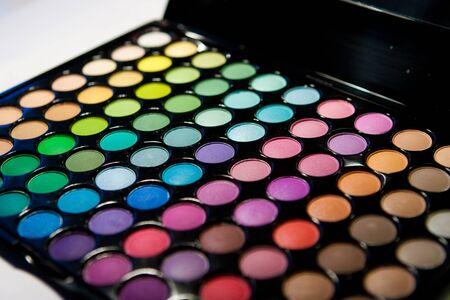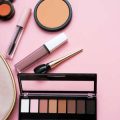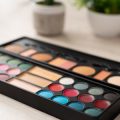Origins of Mascara and Eyeliner in Britain
The story of mascara and eyeliner in British makeup culture begins far before the swinging sixties and the punk revolution; it is deeply rooted in the ancient world. Both products have been inspired by civilisations such as Ancient Egypt, where kohl was used not only to define the eyes but also for spiritual and medicinal purposes. As trade routes expanded and cultural exchange flourished, these practices gradually found their way into Britain, where they were adapted to suit local tastes, customs, and materials.
Early Influences from Ancient Civilisations
During the 19th century, archaeological discoveries and imperial connections exposed British society to exotic beauty rituals. The fascination with Egyptology, particularly after the discovery of Tutankhamun’s tomb in 1922, led to a surge in popularity for bold eye makeup among fashionable Britons. Victorian-era women experimented with homemade concoctions for darkening lashes and brows, often using soot or elderberry juice—methods that echoed ancient traditions while adapting them to available resources.
Adoption within British Society
As these influences permeated British culture, mascara and eyeliner began to symbolise both glamour and mystery. However, societal attitudes towards cosmetics were complex; during much of the 19th century, heavy makeup was associated with the stage or with “fallen women.” It wasn’t until the early 20th century that eye makeup became more mainstream, thanks largely to advances in cosmetic chemistry and changing social norms.
Key Milestones: Introduction Timeline
| Period | Influence/Event | British Adaptation |
|---|---|---|
| Ancient Times | Kohl used by Egyptians | Imported ideas via trade, limited usage |
| Victorian Era (1837–1901) | Interest in ancient civilisations grows | Homemade lash/brow tints emerge among upper classes |
| Early 20th Century (1900s–1920s) | Tutankhamun’s tomb discovered | Mascara/eyeliner enter mainstream fashion circles |
This early period set the stage for a uniquely British approach to eye makeup—a blend of ancient inspiration and contemporary adaptation that would continue to evolve throughout the decades.
Victorian Era: The Dawn of Modern Eye Makeup
The Victorian era marked a subtle yet significant shift in the history of British makeup, laying the groundwork for modern mascaras and eyeliners. During this period, beauty was closely associated with morality and virtue, leading to a preference for an understated, natural look. Nevertheless, interest in enhancing the eyes began to emerge among fashionable circles, albeit discreetly.
Societal Attitudes towards Eye Makeup
In Victorian Britain, overt use of cosmetics was often frowned upon, as it was linked to vanity or even questionable morals. Women were encouraged to maintain a demure appearance, but the desire for brighter, more defined eyes persisted. As a result, mascaras and eyeliners were used sparingly and in secret by those who wished to subtly enhance their features without attracting undue attention.
Available Formulas and Ingredients
Eye makeup products during the Victorian era were simple and largely homemade. Below is a table outlining common formulas used at the time:
| Product | Main Ingredients | Purpose |
|---|---|---|
| Mascara (Early Form) | Beeswax, coal dust, elderberry juice | Darken and define lashes |
| Eyeliner (Kohl) | Powdered antimony, soot mixed with oils | Outline and intensify the eyes |
Application Techniques
Victorian women applied eye makeup with great care to avoid detection. Mascara was typically brushed onto lashes using tiny combs or small brushes fashioned from bone or ivory. Eyeliner—often referred to as kohl—was delicately applied along the lash line using fine sticks or fingers. The goal was always subtlety: enough definition to make the eyes appear larger and more expressive, but never so much as to betray the use of cosmetics.
Cultural Impact on Beauty Routines
This era’s cautious approach to eye makeup influenced British beauty standards for generations. While bold looks were still decades away, the quiet adoption of mascaras and eyeliners during the Victorian period set the stage for their eventual mainstream acceptance and innovation in formulations that followed.

3. Post-War Britain: Hollywood Glamour and Accessibility
In the aftermath of World War II, British society underwent a remarkable transformation, particularly in terms of beauty ideals and consumer culture. The silver screen became a powerful influence, with Hollywood films flooding UK cinemas and introducing British women to iconic starlets such as Audrey Hepburn, Elizabeth Taylor, and Marilyn Monroe. These actresses personified glamour with their striking lashes and defined eyes—looks achieved through artful use of mascaras and eyeliners. Inspired by these international icons, British women began to crave the allure of dramatic eye makeup, marking a turning point in both aspiration and accessibility.
The Influence of Hollywood on British Beauty
Hollywood’s impact on British makeup habits was profound. The 1950s saw a surge in interest for bold eyeliner flicks and voluminous lashes, styles popularised by film stars. This era also coincided with the rise of colour films, which further emphasised the importance of expressive eyes on screen. British cosmetic brands responded by making mascaras and eyeliners more widely available and affordable, adapting their marketing to capture this newfound demand.
Shifts in Product Availability
| Year | Product Innovation | Accessibility in Britain |
|---|---|---|
| 1945-1950 | Cake mascara & kohl pencils (imported) | Mainly high-end retailers; limited access for most women |
| 1950-1960 | Tubed mascaras & liquid eyeliners | High street chemists begin stocking affordable options |
Key Cultural Shifts
- Rationing ended, allowing greater production and sale of cosmetics.
- Younger generations embraced American film trends over traditional British restraint.
- Women’s magazines featured step-by-step tutorials inspired by Hollywood makeup artists.
This period solidified mascaras and eyeliners as staples within the British beauty routine, not only reflecting changing societal values but also bridging the gap between aspirational glamour and everyday practicality. The post-war years marked the beginning of mass-market accessibility for eye makeup, ensuring that the allure once reserved for film stars became attainable for millions of British women.
4. The Swinging Sixties and Youth Subcultures
The 1960s marked a revolutionary era in British makeup culture, with the rise of youth subcultures like Mods and Rockers fundamentally transforming beauty standards. London became the epicentre of global fashion, and the iconic ‘Swinging Sixties’ aesthetic was defined by bold experimentation—especially around the eyes.
Mods: Clean Lines and Graphic Statements
The Mod movement brought a futuristic approach to makeup, favouring clean, graphic lines and a monochromatic palette. Twiggy, Britain’s most famous model of the decade, epitomised this look with her spidery lashes and exaggerated lower-lash lines. Liquid eyeliners were used to create sharp cat-eyes or delicate flicks, while mascaras were layered for dramatic volume and definition.
Rockers: Rebellious Glamour
In contrast, Rockers—rooted in motorcycle culture—embraced a more rebellious, smudged eyeliner style. Their eye makeup exuded an effortless cool, favouring kohl pencils for a lived-in effect. The juxtaposition between Mods’ precision and Rockers’ rawness underscored the diversity and creativity within British beauty trends.
Key Eye Makeup Trends of the Sixties
| Subculture | Eyeliner Style | Mascara Application | Iconic Reference |
|---|---|---|---|
| Mods | Sharp liquid liner flicks Graphic lower lash lines |
Thickly layered on upper & lower lashes Defined spider-lash effect |
Twiggy, Mary Quant |
| Rockers | Smudged kohl pencil Dark waterlines |
Minimal application Natural but intense gaze |
Marianne Faithfull, Dusty Springfield (early career) |
This dynamic decade established mascara and eyeliner as essential tools for self-expression among British youth, setting trends that would ripple through global pop culture for years to come.
5. Contemporary Trends: Diversity and Innovation
The modern British beauty scene has witnessed a remarkable transformation in the realm of mascaras and eyeliners, where inclusivity, innovation, and ethical standards take centre stage. Today’s UK makeup culture is no longer limited to mainstream trends but champions individuality and caters to a diverse spectrum of eye shapes, skin tones, and personal styles.
Inclusivity at the Forefront
Brands and artists across Britain are embracing products that celebrate diversity. Mascaras now come in formulas designed for different lash types, from volumising options for fine lashes to curling mascaras for stubbornly straight ones. Eyeliners are available in an impressive array of shades, moving beyond classic black to embrace vibrant colours that complement all complexions.
Cruelty-Free & Ethical Beauty
The demand for cruelty-free and vegan products has soared among British consumers. Many leading UK brands have responded by securing certifications from recognised organisations such as Leaping Bunny or The Vegan Society. This shift reflects a wider cultural emphasis on ethical consumption and environmental responsibility.
| Brand | Cruelty-Free | Vegan Options | Innovative Features |
|---|---|---|---|
| Charlotte Tilbury | Yes | Select Products | Pillow Talk Push Up Lashes Mascara – unique diamond-shaped brush |
| Rimmel London | Yes (selected lines) | Yes | Wonder’Luxe Volume Mascara with argan oil; 24hr waterproof eyeliners |
| Sleek MakeUP | Yes | Yes | Intense waterline eyeliners for deeper skin tones; full fibre mascaras |
| Barry M | Yes | Yes (majority) | Brow & Lash Gel with plant-based fibres; felt-tip precision eyeliners |
Cutting-Edge Applicators & Formulations
The British beauty industry is renowned for its innovation, especially regarding applicators that suit the fast-paced lifestyles of urban dwellers. From flexible silicone mascara wands for clump-free definition to ultra-fine felt-tip eyeliner pens that allow even beginners to achieve perfect flicks, technology is at the heart of product evolution.
Popular Modern Applicator Types in the UK:
- Tubing Mascaras: Encapsulate each lash for easy removal—ideal for sensitive eyes.
- Duo-ended Liners: Feature both pencil and liquid tips for versatile looks.
- Cushion Liners: Inspired by K-beauty, allowing customisable thickness.
- Bristle Variations: Hourglass, curved, or micro brushes to cater to every lash shape.
A Culture Embracing Change
This commitment to diversity and forward-thinking design is what defines contemporary British makeup culture. Whether on the High Street or showcased backstage at London Fashion Week, today’s mascaras and eyeliners embody Britain’s passion for creativity, ethics, and genuine self-expression.
6. British Icons and Eye Makeup Influence
British makeup culture has been profoundly shaped by an array of celebrities and makeup artists whose distinctive approaches to mascaras and eyeliners have left an indelible mark on the industry. From mod subculture icons to today’s trendsetters, these figures have not only influenced local beauty standards but also set global trends.
Influential Figures in British Eye Makeup
| Name | Era | Signature Eye Look | Impact on Mascara & Eyeliner Evolution |
|---|---|---|---|
| Twiggy | 1960s | Dramatic lower lashes, graphic liner | Pioneered the bold, doll-like mascara effect; popularised exaggerated eyeliner shapes |
| Adele | 2010s–present | Sharp winged eyeliner, voluminous lashes | Brought renewed focus to precision liquid liners and high-impact mascaras in mainstream beauty |
| Charlotte Tilbury | 1990s–present | Smoky eyes, lush lashes | Innovated with new mascara formulas and liner textures, influencing product development and professional techniques |
The Legacy of British Makeup Artists
Makeup artists such as Lisa Eldridge and Pat McGrath have become household names, known for their technical mastery and creative vision. Their signature looks often emphasise expressive eyes—whether through experimental use of colour or flawless definition—which has propelled the demand for versatile mascaras and eyeliners in the UK market. These artists frequently collaborate with brands to develop products tailored for British complexions and style preferences, further cementing the UK’s reputation for innovation in eye makeup.
Cultural Impact on Trends and Identity
The influence of these British icons extends beyond individual style; they have collectively contributed to a national identity that celebrates both classic elegance and avant-garde creativity. Whether it’s the understated sophistication preferred by Kate Middleton or the edgy glamour favoured by pop stars like Little Mix, British consumers enjoy a wide spectrum of mascara and eyeliner styles that reflect the diversity of their cultural heritage.
Conclusion: Shaping the Future of Eye Makeup
By spotlighting these trailblazers, it is clear that British celebrities and makeup artists play a pivotal role in evolving mascara and eyeliner trends. Their continued innovation ensures that British makeup culture remains at the forefront of global beauty conversations—where tradition meets transformation with every brushstroke.


